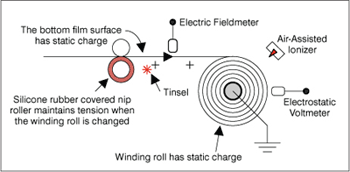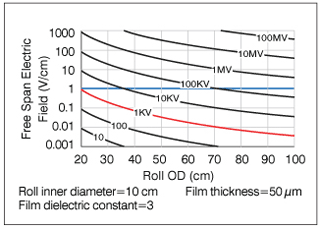Film Charge Causes Winding Static
- Published: June 01, 2009, By By Dr. Kelly Robinson Contributing Editor
Valuable product is delivered to customers in wound rolls. Unfortunately, the wound rolls often contain product defects, dust particles, and static charge. To satisfy their customers, manufacturers work hard to eliminate defects, dust, and static.
Eliminating static on a winding roll is challenging because the roll can accumulate a large amount of charge — enough to cause headaches for customers, pose a safety risk to operators, and threaten damage to equipment. Follow this procedure to solve winding roll static.
- Use an electric fieldmeter on free spans to measure the film charge.
- Start near the winder and work your way upstream until you find the source charging.
- Install a static dissipater, such as a static brush, tinsel, or a static bar, to dissipate the film charge. Be sure to install the static dissipater so it faces the film surface that is charged.
- Finally, install a static dissipater on the winding roll, such as an air-assisted ionizer or antistatic cloth draped over the winding roll.
Ionizers on the winding roll will only protect your process. They will not help your customer. Here's why. There are two important mechanisms for generating high static on winding rolls.
- Winding a roll of charged film.
- Winding a roll of film with positive charge on one surface and an equal amount of negative charge on the other surface.
Here, we'll discuss winding charged film. Next time, we'll tackle winding film with positive charge on one surface and a negative charge on the other surface.

At a roll start, the film in Figure 1 is attached to a fresh core on the winder. Tension is maintained by the silicone rubber nip roller. While running, the roller deposits positive static charge on the lower surface of the film. As the roll winds, the voltage increases to thousands of volts until the roll sparks to the nearest grounded object. Even a little bit of charge is enough to cause a big problem. Measure the charge on the film using an electric fieldmeter on a film span near the winder. The plot in Figure 2 shows that a reading of only about 5 V/cm is enough film charge for the potential of a 50 cm diameter winding roll to exceed 100 kV.

Installing an air-assisted ionizer near the winding roll as in Figure 1 will control stockroll potential and prevent sparks. However, the winding roll still holds static charge and likely will have high static when unwound at the customer site. The positive charge from the silicone rubber roller is on the bottom or inner surface of the film. The ionizer cannot neutralize the static because it deposits negative charge on the outer surface of the roll. All of the charge from the silicone roller and from the air-assisted ionizer is delivered to the customer.
The solution is to install tinsel or a static bar just downstream of the silicone rubber roller so the bottom surface of the film is exposed to the static dissipater as shown in Figure 1. In this location, the tinsel or ionizer deposits negative charge on the bottom surface of the film so the charge from the silicone rubber roller is neutralized.
Since no ionizer is perfect, the best practice is to install a static dissipater on the winding roll in addition to static dissipaters along the film path. For a winding roll, the static dissipater can be an air-assisted ionizer or an antistatic cloth draped over the winding roll.
Static control expert Dr. Kelly Robinson, president of Electrostatic Answers, has 27+ years of experience in problem-solving and consulting. Contact him at 585-425-8158; This email address is being protected from spambots. You need JavaScript enabled to view it.; www.electrostaticanswers.com.




